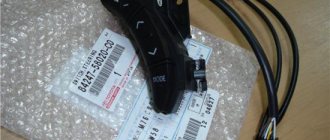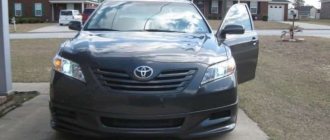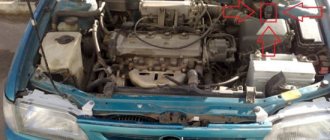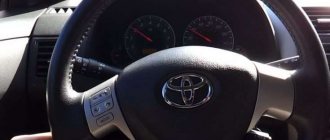Useful tips
On the dashboard of any car there are signal icons that inform the driver about the operation of certain mechanisms, as well as about malfunctions.
These icons help you always know what's going on with your vehicle.
Over the past few years, indicators have evolved from ordinary light bulbs to various glowing icons that are simple to understand, easy to see, and generally these indicators have become much more informative.
Different indicators have different colors.
What do the colors of the icons on the dashboard mean?
Red
Typically, red indicates a serious problem or some unresolved security issue. The color red is also used to indicate important reminders.
Yellow orange)
Typically, icons are colored yellow or orange to indicate that a particular part of the car requires repair or needs servicing. However, if the icon of this color begins to blink, then you should contact the workshop as soon as possible.
Green or blue
Icons of this color are used exclusively to provide the driver with additional information about the stable operation of the system.
Useful tips
* After one red or yellow indicator lights up, you should not wait for others to light up, since the longer you delay visiting the workshop, the greater the risk of an even more serious breakdown of the car increases, which can, in turn, lead to very unpleasant consequences.
* Try to carry out regular technical inspections, which will help avoid unexpected malfunctions. Always pay attention to the dashboard icons and you will be aware of the operation of all vehicle systems.
How to remove the tidy
To replace the board, you must follow a certain sequence of actions.
- Disconnect the terminals from the battery.
- Remove the steering column trim; to do this, you need to unclip the plastic terminals and remove the shields.
- Remove the steering wheel. Here the trim is twisted and the steering wheel is detached from the rack along with the switches.
- Use a flat-head screwdriver to pry up the panel trim and unclip it.
- Unscrew the screws and carefully lift the shield.
- Reach under the panel and disconnect the connectors from it.
Installation is performed in reverse order.
Dashboard icons
Warning symbols
1. Front fog lights are on.
2. Such an indicator may mean: a malfunction in the electric power steering or power steering.
3. Rear fog lights are on.
4. Low level indicator for windshield washer fluid.
5. The brake pads are worn out and need to be replaced.
6. An indicator indicating that the constant speed control system is turned on (cruise control).
7. Indicators of working turn signals.
8. Indicator of active rain and light sensor.
9. An indicator indicating that the outside temperature is below zero.
10. Information message.
11. Glow plug indicator.
Lighting devices
| Symbol | Designation |
| The headlights are on and the lighting fixtures are operating normally. | |
| An indicator indicating that the vehicle's adaptive optics system is disabled. If the icon blinks, this indicates a malfunction of one of the lighting elements. | |
| A symbol indicating that the system for automatically activating low-beam headlights is turned on during daylight hours. | |
| Malfunctions were detected in the operation of external lights. | |
| This indicates that the high beam mode is on. | |
| The lamp switching function is enabled. | |
| The headlight leveling mechanism does not work or errors have occurred. | |
| Malfunctions in the electrical circuit, rear lights do not function or work incorrectly. Also, such a symbol may indicate a malfunction of the brake lights. | |
| The fog lights mode is activated. | |
| If the car is equipped with rear fog lights, then this light indicates that they are on. | |
| The side lights are activated. | |
| The vehicle's lights are activated or the turn signal is turned on. |
If the lights or at least one of them start blinking on the control panel, first of all you need to diagnose certain characteristics of the vehicle. Sometimes the problem is quite minor, for example, one of the sensors has failed. But in some cases, problems with wiring lead to very sad consequences and expensive repairs.
What do the icons on the dashboard mean?
26. Towbar warning indicator.
27. Air suspension warning indicator.
28. Lane change indicator.
29. Indicator indicating catalyst overheating.
30. Indicator indicating that the seat belt has not been fastened.
And such an indicator warns that the seat belts of the rear passengers are not fastened.
31. If the handbrake icon turns on, it can mean one of three things:
* The handbrake lever is raised.
* Brake pads are worn out.
* Low brake fluid level - it needs to be topped up or replaced.
If the car is equipped with an electronic handbrake, then this indicator informs about a problem with the limit switch or sensor.
You can also find an indicator that informs you that the brake fluid level is below normal.
32. Battery charge indicator.
33. Parking assistance system indicator.
34. Indicator indicating the need for maintenance.
35. Adaptive headlights are on.
36. Problems with the automatic headlight leveling system.
37. Problems associated with the rear spoiler.
38. This indicator can be found in convertibles and signals a problem with the car's roof.
39. There is a problem with the airbag.
Controls
Dashboard
The following controls and instrumentation are located on the instrument panel. For ease of use, the handles, buttons and control devices located on the instrument panel are marked with symbols of their functional purpose.
1 – nozzles of the interior ventilation and heating system are designed to regulate the air flow from the heater, air conditioner or ventilation system. The direction of air flow is adjusted by turning the deflectors in the appropriate direction.
At the bottom of the nozzles there is a handle for adjusting the amount of air supplied through them.
When the handle is turned all the way to the right, the damper opens completely (maximum air flow). When the handle is turned all the way to the left, the damper closes completely, cutting off the air flow. By placing the handle in intermediate positions, the amount of air flow is adjusted.
2 – lever for switch of external lighting and direction indicators. The lever switches the following operating modes of the switch:
– mode of turning on the direction indicators.
Move the lever up or down until the turn indicators turn on. When you move the lever up or down in the instrument cluster, the indicator 10 or 7 starts flashing, respectively. When the steering wheel returns to the straight-ahead position, the lever is automatically set to its original position. When changing lanes, to turn on the turn signal, it is enough to press the lever in the up or down direction only until the moment of noticeable resistance, without fixing the lever. When released, the lever will return to its original position;
The turn signal only works when the ignition is on.
– mode of turning on the headlights.
To turn on the headlights, turn handle A of the switch lever around its axis. When the headlights are turned on, the switch can have two positions:
– the side lights in the front and rear lights are turned on, as well as the illumination of the instrument cluster;
– low beam is on. To switch the headlights from low beam to high beam, move the lever away from you. When the high beam headlights are turned on, the warning light in the instrument cluster lights up.
To signal high beam headlights, move the switch lever one position towards the steering wheel (the exterior lighting switch knob must be in position) and release.
To turn on the fog lights, turn switch B and align with the icon.
To turn off the fog lights, turn switch B to the “OFF” position.
3 – lever for manual downshifting in the gearbox (see “Gearbox Control”).
4 – steering wheel. The following switches and keys are located on the steering wheel:
– horn switch. To turn on the sound signal, press anywhere on the steering wheel pad;
– Bluetooth system keys with the ability to control the phone and a button to turn on the speed limiter: A – button to answer incoming phone calls; B – speakerphone switch; B – speed limiter button;
– audio system control keys from the steering wheel. The buttons located on the left side of the steering wheel can be used to control certain audio system functions. A – volume key; B – file selection key, search for radio stations or fast forward and backward movement; B – audio system power switch.
6 – ignition switch (lock), combined with an anti-theft device, is located on the right side of the steering column. The key in the lock can be in one of four positions:
LOCK – the ignition is turned off, and the anti-theft device is turned on when the key is removed. To ensure that the steering shaft is locked, turn the steering wheel to the right or left until it clicks. To turn off the anti-theft device, insert the key into the ignition switch and, turning the steering wheel slightly left and right, turn the key to the “ACC” position;
Dashboard indicators
40. The red exclamation point can have several explanations, and it looks different:
* If the sign is in a circle, there is a problem with the brake system. It is better to stop and not continue driving.
*Handbrake activated.
* Brake pads are worn out.
* Low brake fluid level. This is the most annoying problem as the brake hose may have been damaged.
Quite often this indicator lights up if the float (level sensor) is faulty.
In some cars, this indicator is accompanied by the word “BRAKE”, but its essence remains the same.
41. Water was detected in the fuel filter.
42. Side Airbag Off - translated as “the side airbag is turned off.” The same icons may indicate that the front airbag is disabled.
43. Fault detected.
44. Low beam headlights are on.
45. The indicator indicates that the air filter is dirty.
46. Fuel saving mode activated. This indicator looks different on different cars.
Basic symbols
| Icon | Designation |
| A light with an exclamation mark or the inscription Brake indicates that the car's handbrake is on. However, if the indicator appears while driving, it may indicate a problem with the brake system. | |
| If the indicator is red, this indicates a very high engine temperature. When it appears, you need to stop and check whether the coolant is boiling, but it is better not to turn off the car’s engine. If the light blinks, there may be a problem with the wiring. If the icon lights up blue, this indicates that the power unit has not yet warmed up. This indicator always appears when starting a cold engine. It is not recommended to operate the engine under increased loads or at high speeds until this indicator disappears. | |
| Indicates a decrease in the level of engine fluid pressure, and may also indicate its deficiency. | |
| The red battery icon indicates a drop in the voltage level in the car's electrical circuit. In addition, in some cases, such light bulbs appear as a result of the generator not working correctly or there being other electrical problems. Low battery charge. Sometimes the decision to charge the battery helps. |
Symbols on the dashboard
47. Assistance and safety system indicators
These indicators show the activity of the hill descent assist system or the safety system while driving uphill.
48. Red - the temperature of the cooling system is higher than normal.
The same blue indicator indicates that the cooling system temperature is below normal.
49. ABS - Antilock Braking System.
This indicator lights up when:
* Malfunctions in the ABS system
*ABS has been intentionally disabled.
50. An indicator indicating water in the fuel system or other problems associated with this system.
51. The indicator lights up when the door is open.
52. The indicator lights up when the hood is open.
53. Low fuel level indicator.
54. Indicator indicating a problem with the automatic transmission. The automatic transmission or other parts of the transmission may overheat.
55. Automatic Speed Limiter (ASL) is turned on.
56. Suspension shock absorber indicator.
57. This icon can mean:
* The pressure level in the engine lubrication system (Oil Pressure) has dropped.
* Oil level is below the permissible value.
58. Indicator that the windshield heating is on.
59. Indicator informing about an open trunk.
For diesel vehicles
Depending on the manufacturer, the bulbs may vary.
| Symbol | Designation |
| The indicator always appears when the ignition system is activated. After starting the power unit, the icon should disappear. If it continues to burn, this indicates a malfunction of the glow plugs. | |
| The particulate filter element is clogged or working normally. | |
| Lack of working fluid in the exhaust system. | |
| Problems in the functioning of exhaust gas cleaning devices. | |
| The presence of condensate in the fuel system, it is necessary to remove the liquid and check its performance. | |
| Problems with the electronic fuel injection control system. The car's power unit may function unstably, stall randomly, and not start. The appearance of the icon may be due to contamination of the fuel filter device, breakdown of the injectors or valve in the fuel pump. Also, the reason sometimes is airing of the fuel system. | |
| The control unit reports the detection of moisture in diesel fuel. The icon may indicate an error in the operation of the electronic powertrain control systems. | |
| Typically this indicator turns on when the ignition is turned on. If it continues to light after starting the engine, then the driver should know that the timing belt needs to be replaced as soon as possible. |
What do the different signs on the dashboard mean?
60. Stability Control is disabled.
*If the Check Engine light is on, this system will automatically turn off.
Different manufacturers have their own names for this system: Automatic Stability Control (ASC), Dynamic Stability Control (DSC), Vehicle Dynamic Control (VDC), Vehicle Stability Control (VSC) and others.
If the knees begin to slip, the system will begin to level the vehicle using the brake systems, suspension control system, and fuel delivery system.
If the icon blinks, there is an electrical problem with the cooling system.
61. The rain sensor is turned on.
62. When the engine is running, this indicator warns that the engine and its system require diagnostics. This may cause some vehicle systems to shut down and stop working until all problems have been properly corrected.
63. The indicator informs you that the rear window heating is on.
64. Automatic windshield cleaning is activated.
Description of other important dashboard indicators
Engine Oil Sensor - engine oil level indicator.
An icon with the inscription MAIN usually appears in hybrid models, and it informs about a problem in the power supply system.
The following indicators indicate malfunctions. They are part of the car's security systems.
This indicator lights up along with a warning message on the instrument panel screen.
In European cars, a similar yellow indicator indicates a malfunction of the stability control system.
SRS - Supplemental Restraint System. If this icon lights up, the passive safety system informs you that the airbag is faulty.
Camry 30 panel
For a car in the E30 body, the manufacturer provides a completely analogue dashboard. The only exception is the presence of a digital clock display. The compact placement of the switch elements is original. The fuel level and antifreeze temperature gauges are neatly placed under the speedometer and tachometer. Such a solution looks unusual and attractive.
Vehicle system malfunction sensors and safety warnings
RSCA - Roll Sensing Curtain Airbags. This indicator turns off automatically when an adult gets into the car. If the message AIRBAG OFF is on, then a malfunction has been found in the system.
The indicator, which is responsible for the passenger airbag, informs about the status of the passenger airbag.
If this icon lights up, it means that the side airbag system, which should be activated when the car overturns, is not functioning. The system can be turned off when the driver is about to drive off-road, as due to large body rolls, the system sensors can be activated.
PCS - Pre Collision (Crash) System. This indicator informs you that the pre-collision safety system is not working.
Anti-theft immobilizer icon. This indicator informs about the activation of the immobilizer (anti-theft system). When this indicator lights up, there may be problems with the anti-theft system.
This type of indicator is typically found on sports cars. It can warn about:
* Transmission overheating. There is a danger that the vehicle will become uncontrollable.
* Clutch problem.
* Faults in one of the transmission units.
Transmission oil temperature is too high.
(A/T - Automatic Transmission)
This icon indicates that the temperature in the automatic transmission is above the permissible level. In this case, it is not recommended to continue driving. You should wait until the automatic transmission cools down.
Electrical fault in the automatic transmission. Also, don't keep moving.
Automatic transmission lock mode indicator in the “parking” position.
P - parking
A/TP - Automatic Transmission Park
As a rule, such an indicator can be found in cars that are equipped with all-wheel drive, and also contain a reduction range in the transfer case.
The transmission locks when the all-wheel drive mode switch is in position (N).
If your indicator is on, which shows an automatic transmission, and under the picture there is the inscription “auto”, then this may mean:
* The oil level in the box is too low.
* Low oil pressure.
* Fever.
* Sensor malfunction.
* Electrical wiring fault.
It is worth noting that in such cases the box goes into emergency mode (i.e. 3rd gear is activated).
This indicator is called "shift up". It informs you that for the greatest fuel economy you should switch to a higher gear.
Malfunction in the brake force distribution system.
Problems with the electric parking brake system.
Start-Stop system indicator.
The green indicator indicates that the car's engine is turned off.
The yellow indicator informs about a malfunction in the system.
This indicator indicates a decrease in engine power. This problem can sometimes be solved by turning off the engine and restarting it after 10 seconds.
This indicator lights up in 4 cases:
* Problems in the transmission electronics.
* Problems with engine operation.
* Malfunction of the injection system.
* Malfunction of the immobilizer (electronic anti-theft device).
Lambda probe icon.
This indicator lights up if the oxygen sensor is dirty or faulty.
Further movement is not recommended, as this sensor has a direct impact on the operation of the injection system.
When this indicator comes on, it means the catalytic converter is overheating or malfunctioning. In addition to the activation of this icon, engine power usually drops.
This light tells you to check your fuel cap.
If this indicator is on, it may mean the following:
* Another indicator turned on.
* A new message has appeared on the instrument panel.
* Certain service functions must be performed.
Please refer to your vehicle's owner's manual.
Low coolant level in the engine cooling system.
Problems with the Electronic Throttle Control (ETC) system.
BSM - Blind Spot - this is the designation for the blind spot monitoring system.
1. The system is disabled.
2. The system is faulty.
Icon meaning:
1. It's time to do scheduled maintenance, change the oil, etc.
2. Serious problems that need to be fixed.
The intake system air filter needs to be replaced as it is dirty.
Night View - this is the designation for the night vision system. This icon means that:
1. An error has occurred in the system.
2. Infrared sensors have burned out.
Overdrive - O/D (“overdrive”) - overdrive gear. This indicator indicates that the overdrive gear in the automatic transmission is turned off.
For hybrid cars
Since hybrid cars are not new today, we suggest you familiarize yourself with the description of their indicators.
| Symbol | Definition |
| The main battery or high voltage circuit battery is faulty. When the indicators appear, you should check the operation of the battery, make sure that there is an electrolyte solution in the jars, and that there are no cracks in the case. These icons may also indicate a malfunction of the generator device or a breakdown of its voltage regulator relay. | |
| Battery too low. This does not apply to batteries, we are talking about a high-voltage battery. | |
| It is necessary to charge the battery as quickly as possible. | |
| Vehicle power is reduced. | |
| The indicators are triggered when there is a malfunction of the external audio warning system for pedestrians about the approach of a vehicle. Damage to sensors installed on the car body is possible. | |
| Indicators indicating problems in the operation of electric vehicles. A yellow icon indicates a minor problem, and when a red symbol appears, operating the car is unacceptable. With such indicators, the power of the power unit may decrease, which indicates activation of the emergency operating mode. | |
| The hybrid vehicle icon indicates that the vehicle is ready to move. | |
| Battery charge icons on electric vehicles. | |
| Electric traction mode enabled icon for hybrid vehicles. | |
| Problems have arisen in the operation of the machine's electric drive. |
Meanings of the assistance and stabilization system icons on the dashboard
The traction control indicator may be indicated differently:
TRAC - Traction and Active Traction Control
DTC - Dynamic Traction Control
TCS - Traction Control System
Green indicator - informs about the operation of the system.
Yellow indicator - the system is turned off or an error has occurred in its operation.
* It is worth noting that this system is connected to the braking system as well as the fuel supply system, and therefore faults in one (or both) of these two systems may cause the traction control system to disable.
ESP - Electronic Stability Program - this is the designation for the emergency braking assistance system
BAS - Brake Assist System - this is the designation for the stabilization assistance system. Both of these systems are interconnected, and this indicator indicates problems in one of these systems.
KDSS - Kinetic Dynamic Suspension System - this is the designation for the kinetic suspension stabilization system. This indicator indicates a malfunction in this system.
Vehicle Stability Control (VSC), Dynamic Stability Control (DSC) stabilization system indicator icon.
For some car manufacturers, this icon denotes an electronic locking differential, in short EDL (Electronic Differential Lock), as well as an anti-traction system, briefly designated ASR (Anti-Slip Regulation).
This indicator can indicate that:
1. The system needs diagnostics.
2. All-wheel drive is engaged.
BAS - Brake Assist System - assistance system in case of emergency braking.
ASR - Electronic Anti-Slip Regulation - electronic traction control system.
If this indicator lights up, it means that there has been a failure in the BAS system, which in turn leads to the deactivation of the ASR system.
IBA - Intelligent Brake Assist - intelligent assistance system in case of emergency braking. This system automatically activates the braking system if an obstacle appears dangerously close to the vehicle.
This indicator indicates that the IBA system is deactivated. But if the system works and the indicator is on, then there is a problem with the system's laser sensors.
This indicator indicates that the car is slipping, which means that the stabilization system has turned on.
This indicator informs you that the stabilization system is malfunctioning or that it is not functioning.
In this case, you can continue to drive the car, but the electronics will not help you stay on a slippery road.
Stability systems
| Bulb | Meaning |
| If such lamps come on, they indicate that the vehicle stabilization system has been disabled. | |
| When these indicators appear, there may be a problem with the brake assist and stability control system. | |
| The anti-skid system does not work or does not function correctly. The vehicle drives without problems, the engine can function without problems, but the electronics do not work. | |
| Activation of the anti-skid system. The vehicle entered a road with a slippery surface. |
Special and additional indicators on the car dashboard
The following indicators can be found in modern vehicles equipped with new technological features.
The green indicator indicates that the function is active.
There are symbols that indicate a problem with a specific function. Typically, such indicators are yellow or red.
The indicator tells the driver that it is time to rest.
Easy access to the car.
Adaptive cruise control activated
Problems with cruise control.
Lane Keeping Assist Indicator.
Such icons may mean:
1. Collision safety system disabled
2. Malfunction in the collision safety system.
The indicator informs you about the risk of a collision at the rear of the vehicle.
The indicator indicates a risk of collision at the front of the vehicle.
Be careful, there is a pedestrian on the road.
The indicator informs you that there is a vehicle in the blind spot.
The indicator informs you that the brake pedal is pressed.
The indicator informs you that the SPORT suspension mode is on.
Towing mode / Indicator indicating the presence of a trailer.
Displays and messages
As you already understood, today many different automakers use different symbols and lights to indicate this or that information. Information symbols are necessary so that the driver always knows how certain components work and which systems need attention first. There are a huge number of such light bulbs; we cannot talk about all of them.
| Icon | Designation |
| If the symbols are not red or yellow, then there are no problems in the operation of the car. The driver only needs to make some adjustments in driving. If the indicator lights up yellow or red, this may indicate a malfunction in the cruise control system. Perhaps one of the nodes is faulty, making it impossible to use. |
Explanation of icons on the dashboard of all-wheel drive vehicles
All-wheel drive mode activated (AWD - All-wheel Drive)
The indicator indicates that the all-wheel drive mode with a low range in the transfer case has been engaged.
Central differential lock indicator. The car operates in “hard” all-wheel drive mode.
Rear differential lock indicator
The indicator indicates that all-wheel drive is deactivated.
The indicator informs about a four-wheel drive malfunction.
Setting up the ESP-8266
Before connecting the ESP8266 Module to the circuit, it must be flashed and configured in Tcp2uart (tcp to uart) transparent bridge mode so that it transmits the received data from the com port to the tablet via Wi-Fi.
It is better to flash via a USB-UART converter, which must have a 3.3V source output to power the ESP8266. Also, this source must provide the required current of at least 200mA.
The CPIO0 contact determines the operating mode of the module. When the contact is not connected, the module operates in normal mode and executes AT commands. When the contact is closed to ground, the module is switched to firmware update mode. Switching the module to firmware mode requires that the CPIO0 pin be connected to ground when power is supplied to the module. If you close the contact while the module is running, the module will not switch to firmware update mode. Now you need to run esp8266_flasher.exe Write the COM port of your converter and select the firmware itself fullflash_tcp2uart.bin (link to the archive of the required firmware). Click Download and wait until the completion process reaches 99%. At this point it will stop and you can turn off the module. Next, you need to supply power to the ESP8266, or directly connect it to the Arduino controller according to the diagram. Once it appears on the power module, run a search for wifi networks on your computer. The ESP8266 network should appear. Connect to it. After this, you need to go to https://192.168.4.1/fsupload in your browser (Enter Name: ESP8266 Password: 0123456789) and download the WEBFiles.bin file to the device (it is in the archive with the firmware). All that remains is to configure the Tcp-Uart bridge. To do this, go to https://192.168.4.1 in your browser. Go to the TCP-UART Settings tab and set the settings as in the screenshot below:
Ready! Now, when the ESP-8266 module is connected to the Arduino, it operates in transparent bridge mode and transmits the necessary data via Wi-Fi.










